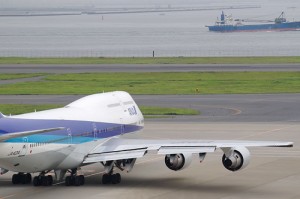
ANA 747-400D(JA401A) which can hold up to 565 passengers
SAVE THE WHALES! It is easier than you might think. You don’t have to donate money, go out and protest, nor send a letter to your congressman. All you need to do, according to All Nippon Airways (ANA), is use the bathroom before you board your flight.
Confused? ANA is stating that if just half their passengers would use the facilities before taking flight, it would save 4.2 tons of carbon dioxide per month.
All joking aside, they might have something here. The more weight on an aircraft, the more fuel it will burn and the more carbon dioxide will be put into the atmosphere. One of their Boeing 747-400D (high density seating) can hold over 560 people. Take 560 x (bathroom times) = a lot of weight.
Now, this is not all that ANA is doing to help out. They have also started using recycled paper cups, plastic bottles, and eliminating glass. They are also showing an eFlight (the “e” standing for “environment” not “electronic”) film to all passengers that states, “This flight is a so-called ‘eFlight.’ The idea behind the operation is to think about the Earth in the sky above. Fuel reduction by lightening the weight of the aircraft will lead to restrain the carbon dioxide emission, which is one of the causes of global warming. Thank you for your understanding.”
Either way, if this saves ANA a few bucks in gas and maybe a whale or two, it works for me. Besides, it is best to go before flight anyhow, so you can avoid using an airplane’s tiny bathroom.
Image: woinary
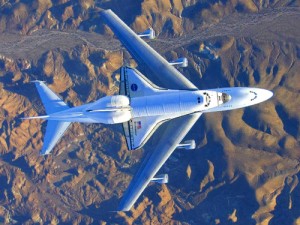
Space shuttle sitting on top of a modified Boeing 747 - Click to see video.
I know it is not directly related to airlines, but close enough. You have a modified Boeing 747 that can fly the Space Shuttle across the country. The process of getting the shuttle on and off the Boeing 747 is not an easy task. A reader pointed out a site that shows a bunch of photos and also a time-lapse video.
Thanks Dan for the tip!
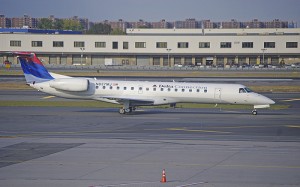
Mesa Air Group-operated ERJ-145 for Freedom Airlines, which runs for Delta Connection
On October 13, 2006, Emily Gillette was breast-feeding her daughter on a Delta Airline’s flight from Burlington, VT to New York City. Gillette, who was 27 at the time, started breast-feeding her 1 year old daughter while still at the gate. She states she was in a position where her breast was not exposed and nothing was indecent. A flight attendant told her she needed to cover up with a blanket and Gillette refused. The flight attendant ordered a customer service representative to kick Gillette and her family off the plane.
Delta is not saying much. Their spokesman Anthony Black said yesterday that the airline does not comment on litigation but supports a mother’s right to breast-feed.
Gillette is suing three airlines: Freedom, Mesa, and Delta. Mesa operates the aircraft for Freedom, who flies for Delta Connection (I know, confusing). Having all three airlines involved is causing issues. The Human Rights Commission in Vermont is also filing a lawsuit, but only against Mesa and Freedom, finding that they couldn’t hold Delta responsible for the other airline’s actions. The commission states the law is clear, ’œa mother may breast-feed her child in any place of public accommodation in which the mother and child would otherwise have a legal right to be.’
Thanks Jessica for the tip!
Source: Current Image: Pix Picks
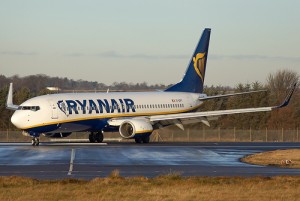
Ryanair Boeing 737-8AS arriving into Edinburgh
Ryanair is back in the news again for another crazy stunt. I hate feeling I am helping their greater plan of getting free publicity, but I am always in awe with what comes up next.
This time Ryanair is looking to cater to those who smoke. But do not worry. If you do not like the cigarette smoke, you are in luck! Ryanair will start to offer smokeless cigarettes, which are not lit and have no smoke. They will sell packs of 10 cigarettes for about $8.75 for all passengers over 18.
So is this a good idea? It allows those who are stressed from flights to have some of that relieved and doesn’t negatively affect those around them. But should an airline support an unhealthy addiction?
Source: NY Daily News Image: Gerry Hill
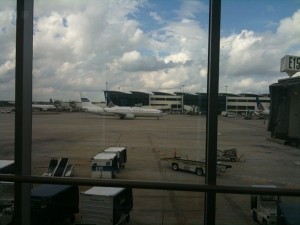
The Continental Blue Skyway livery I got a picture (not a very good one) of today while in Houston.
Alrighty, I am back folks! Sorry about the silence. I took a vacation and was planning on blogging — I don’t see this as work, but as fun. However, you know how vacations can go — I got distracted.
One of the best parts of going on vacation is being able to fly again. On my way back to Seattle from New Orleans, I had a stop over in Houston. I was lucky enough to see Continental’s Blue Skyway special livery (more info).
Anyhow, I don’t want to leave you without your airline news. Here are some of the stories I found interesting this last week:
* Airlines are looking at charging a fee to fly on busy days. (Gadling)
* The hero pilot Sullenberger will start flying again for US Airways (Airline Biz Blog)
* There might be a new flight attendant TV show coming soon (Flight Wisdom)
* United is expanding domestically (BNET)
* New Orleans airport got the green light to go private (USA Today)
* A Southwest Boeing 737-200 ends its glorious career (NutsAboutSouthwest)
That should about do it for now. I will be able to have more regular updates this week, which is great for everyone!




